When you think of a traditional Japanese house, many people probably think of traditional straw tatami mats that have been used as flooring material for centuries. Tatami has been so commonly used in Japanese houses that the size of a room is determined by how many tatami mats can be placed in it, and this custom is still carried on today.
- 1 Q & A
- 2 The number of tatami is a unit of measurement for size
- 3 Size of Tatami
- 4 Structure of Tatami Mat
- 5 Layout of the tatami mats
- 6 Usage for Tatami
- 7 Features of Tatami
- 8 How to clean and maintain Tatami
- 9 Etiquette in using a tatami room
- 10 Sitting styles on Tatami
- 11 Origin of the Japanese word “tatami”
- 12 History of Tatami
Q & A
High quality tatami weighs more than 30 kg and is often used in temples, shrines, and tea rooms. The standard weight of tatami used in ordinary houses is around 25kg per tatami. In recent years, lighter tatami mats that use lighter materials for 畳床 [tatami doko] (たたみどこ) have become available. They weigh about 15 to 20 kg per tatami mat.
If you spill a colored liquid such as juice or soy sauce on a tatami mat, wipe it up as soon as possible.After wiping off the surface, sprinkle salt, flour, baby powder, or other powder that absorbs moisture on the area where the juice has soaked in, and absorb the stain along with the moisture.
After that, use a toothbrush or sponge to scrape out the dirt that has gotten into the grain of the tatami, and then vacuum it up. Finally, wipe the tatami with a well-squeezed cloth and let it dry thoroughly.
The material used to make tatami, イ草 [igusa] (いぐさ) “rushes”, has a unique aroma. It is said that the scent of rushes has a relaxing effect, but I think there are some people who do not like it. New tatami has a particularly strong smell.
If it is not the scent of rushes but the smell after many years of use, there is a possibility that mold has grown on the tatami from moisture or spilled food. Tatami grass has the property of absorbing moisture easily. If the humidity continues to be high, the tatami absorbs excessive moisture, and mold is likely to occur.
– Leaving futons on the floor for a long time
– Keeping the window of the room closed all day
– Eating and drinking in a tatami room most of the time.
If this is the case, it is recommended to change the room’s exposure to the sun or the arrangement of furniture, dry the futon frequently, and ventilate the room.

The number of tatami is a unit of measurement for size
The number of tatami mats indicates the size of the room. When you are looking for a house in Japan, you may find that the size of the room is not listed in square meters on the real estate advertisement.
This is because Japan has a culture that has long been based on the number of tatami mats to realize the size of a room.
However, as mentioned in the topic below, since the size of tatami varies from region to region, the rule “Enforcement Rules for the Fair Competition Code Concerning the Indication of Real Estate” stipulates that 1 square meter is 1.62 square meters.
What is the difference between 畳 and 帖?
Both Chinese characters are read as “jo,” but in Japan, “畳” was originally used as a unit to express the size of a Japanese traditional room 和室 [washitsu] (わしつ).
However, with the change of the times, Western-style rooms have become more common, and so the more versatile “帖” has become more popular instead of “畳” which reminds people of Japanese-style rooms.
Conversion chart for 帖[tsubo] and 坪 [tsubo]
1帖=1.62m2
| 帖 [Jo] | Squire meter (m2) | 坪 [Tsubo] |
| 4帖半 | 7.29 m2 | approx.2.25坪 |
| 6帖 | 9.72 m2 | approx. 3 坪 |
| 8帖 | 12.96 m2 | approx. 4 坪 |
| 10帖 | 16.20 m2 | approx. 5 坪 |
| 12帖 | 19.44 m2 | approx. 6 坪 |
| 18帖 | 29.16 m2 | approx. 9 坪 |
Size of Tatami
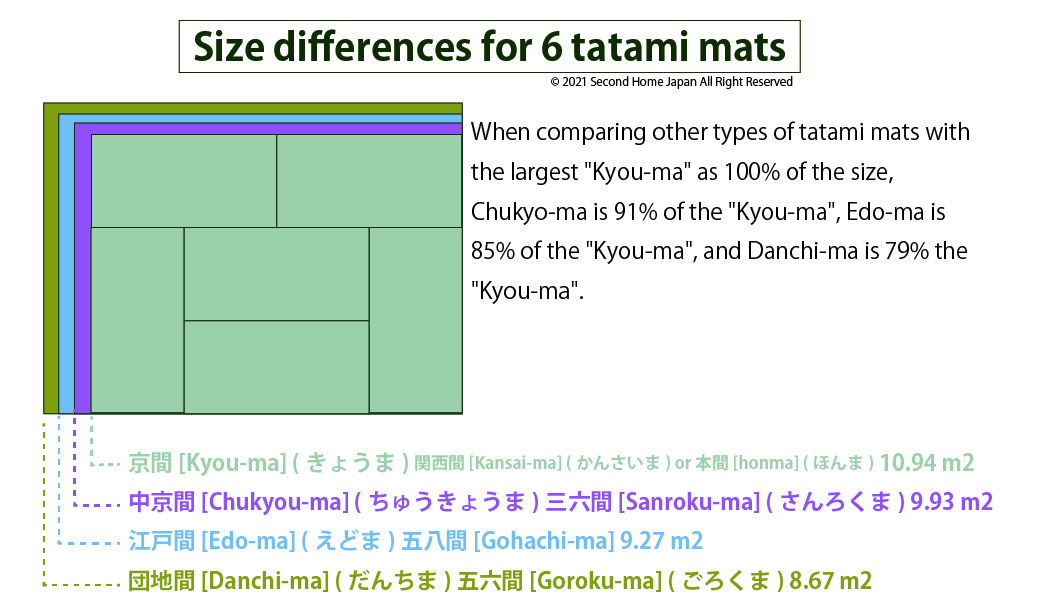 Interestingly, the size of tatami vary depending on the region. In Tokyo, for example, tatami mats are slightly smaller than those in Kyoto. In Japan, the number of tatami mats is often used to indicate the size of a room, even in apartment floor plans.
Interestingly, the size of tatami vary depending on the region. In Tokyo, for example, tatami mats are slightly smaller than those in Kyoto. In Japan, the number of tatami mats is often used to indicate the size of a room, even in apartment floor plans.
The standard tatami mat also has 2 different types: a type with a 2:1 ratio, and another that is a 半畳 [hanjou] (はんじょう) “half size”.
The four most common types of tatami are, in order of size, 京間 [Kyou-ma] (きょうま) , 中京間 [Chukyou-ma] (ちゅうきょうま) , 江戸間 [Edo-ma] (えどま), and 団地間 [Danchi-ma] (だんちま). Let’s take a look at the characteristics of each.
京間 [Kyou-ma] (きょうま)
This type is mostly used in western Japan, and is found in 関西 [Kansai] (かんさい), 中国 [Chugoku] (ちゅうごく), 四国 [Shikoku] (しこく), and 九州 [Kyushu] (きゅうしゅう). Officially, it is called “Kyo ma,” but it is sometimes called 関西間 [Kansai-ma] (かんさいま) or 本間 [honma] (ほんま). The size is 1.91m x 0.955m, and the size of a 6-tatami room is 10.94m2 (square meters).
中京間 [Chukyou-ma] (ちゅうきょうま)
This type of room is mainly found in 愛知[Aichi] (あいち), 岐阜 [Gifu] (ぎふ), and 三重 [Mie] (みえ) prefectures, but is also used in 近畿 [Kinki] (きんき), 四国 [Shikoku] (しこく), and 東北 [Tohoku] (とうほく) prefectures. The size is 1.82m x 0.91m, and the size of a 6-tatami room is 9.93 m2. It is officially called 三六間 [Sanroku-ma] (さんろくま) because it is 6尺3寸 [Roku shaku San sun] (とくしゃくさんすん) “6 shaku long and 3 sun wide”.
江戸間 [Edo-ma] (えどま)
This type of room is literally used in the Kanto region centered on Tokyo and north of 静岡 [Shizuoka] (しずおか). The size is 1.76m x 0.878m, so the size of a 6-tatami room is 9.27m2. It is officially called 五八間 [Gohachi-ma] (ごはちま) because its length is 5尺8寸 [Go shaku Hassun] (ごしゃくはっすん) “5 shaku long 8 sun wide, but it is also called 関東間 [Kanto-ma] (かんとうま) or 田舎間 [Inaka-ma] (いなかま).
団地間 [Danchi-ma] (だんちま)
This is used in public housing, apartments, condominiums, and other apartment buildings regardless of the region. This is a new type of housing that was born when Japan entered a period of rapid economic growth and the need for housing increased, and many housing complexes were built. There is no fixed standard for size, but most of them are 1.7m x 0.85m, and the size of a 6-tatami room is about 8.67m2. Generally, the length is 5 shaku long and 6 sun wide, so it is officially called 五六間 [Goroku-ma] (ごろくま).
When comparing other types of tatami mats with the largest “Kyou-ma” as 100% of the size, Chukyo-ma is 91% of the “Kyou-ma”, Edo-ma is 85% of the “Kyou-ma”, and Danchi-ma is 79% the “Kyou-ma”. This is why people who lived in their parents’ homes in western Japan sometimes feel “cramped” when they move to Tokyo and rent an apartment. That’s why people who lived in their parents’ houses in western Japan sometimes feel “it’s too small!
Why are there various sizes of tatami mats?
As you can see, there are various sizes of tatami mats, and the type used differs depending on the region.
The reason for this is that the length of the original unit of tatami size, 一間 [ikken] (いっけん), has changed over time. In Oda Nobunaga’s time, Ikken was “6 shaku long & 5 sun wide”, but in Hideyoshi’s time it became “6 shaku long and 3 sun wide”, and in the Edo period it became “6 shaku long”, which seems to have influenced the size of tatami.
Another reason is said to be the difference in the way houses are built. The 畳割り [tatami-wari] (たたみわり) method, common in the Kansai region, is based on the size of tatami mats, while the 柱割り[hashira-wari] (はしらわり) method, common in the Kanto region, is based on the distance between pillars (the center of a pillar).
Structure of Tatami Mat
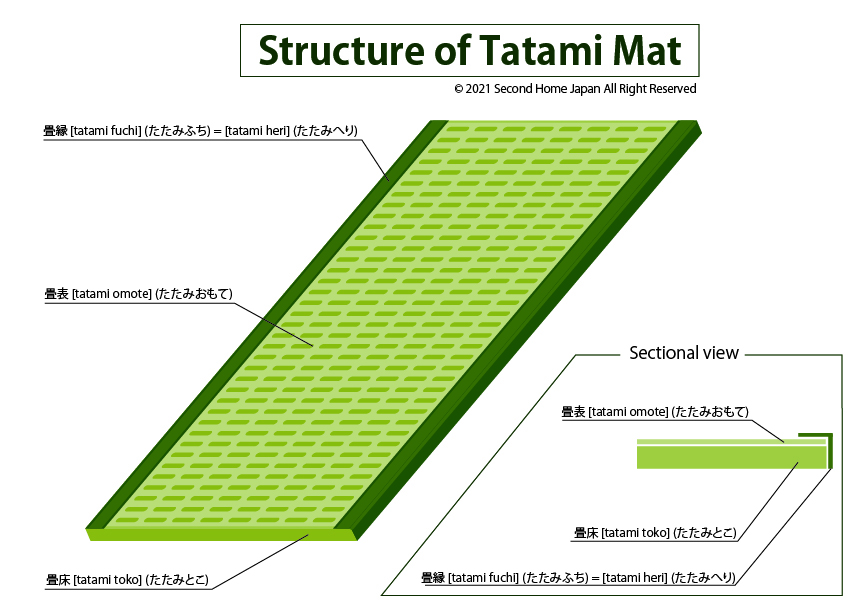
畳表 [tatami omote] (たたみおもて)
Tatami omote is the surface of the tatami. The tatamiomote is made from イ草[igusa] (いぐさ) “rushes”. The rushes are harvested in the summer, dyed with mud, dried, and then woven into warp threads. It is also called ゴザ [gosa] (ござ).
*イ草 [igusa] (いぐさ) : Kumamoto, Hiroshima, Okayama, Fukuoka, and Kochi are famous for producing rushes; 4,000 to 7,000 rushes are used to make one tatami mat. Nowadays, tatami can be woven by machine in about one and a half hours.
畳縁 [tatami fuchi] (たたみふち) = [tatami heri] (たたみへり)
Tatami fuchi is the the edges of tatami mats. A cloth is wrapped around the edge of the tatami to hide the edge of the woven part. Tatami fuchi is made of various materials and designs, and serves to enhance the decorative qualities of the tatami itself.
畳床 [tatami toko] (たたみとこ)
Tatami toko is the floor inside a tatami mat. It used to contain compressed rice straw, but due to the difficulty of removing rice straw and the problem of bugs, it has been replaced by compressed wood pieces or styrene polystyrene.
Layout of the tatami mats
First, let’s take a look at some basic rules about how to lay out tatami.
There are rules on how to lay out tatami
When laying out tatami in an ordinary house, there is a rule that “the tatami should not be arranged in a cross pattern. In order to do this, it is necessary to arrange the tatami so that the four corners of each tatami mat are not gathered in one place.
The way of laying out tatami according to this rule is called 祝儀敷き[Shukugi Jiki] (しゅくぎじき), and the way of laying out tatami contrary to this rule is called 不祝儀敷き [Fushukugi Jiki] (ふしゅくぎじき).
What is 祝儀敷き[Shukugi Jiki] (しゅくぎじき)?
When a tatami room is installed in a house, it is normal to use 祝儀敷き[Shukugi Jiki] (しゅくぎじき). Since the Edo period (1603-1868), tatami has been categorized as 祝儀敷き[Shukugi Jiki] (しゅくぎじき) or 不祝儀敷き [Fushukugi Jiki] (ふしゅくぎじき). Since it was believed that laying tatami in a way that the joints do not form a cross is good luck, 祝儀敷き[Shukugi Jiki] (しゅくぎじき) was chosen for celebratory events such as weddings.
In the past, tatami mats in a room were replaced with non-festival tatami mats for funerals and other events with bad luck, but this custom is no longer practiced today. However, this is no longer the case. Shukugi Jiki is sometimes called 枕敷き[Makura Jiki] (まくらじき).
What is 不祝儀敷き [Fushukugi Jiki] (ふしゅくぎじき)?
As I mentioned earlier, Fushukugi Jiki is used for funerals and other occasions of bad luck. It is also used in temples and shrines, and in large halls of Japanese inns.
It is understandable that Fushukugi Jiki is used in temples and shrines where funerals are held, but why is Fushukugi Jiki also used in the hall of inns?
The reason why Fushukugi Jiki is used in the hall of an inn is that many people often sit facing the same direction, and if all the tatami mats are laid in the same direction, the tatami will not be damaged easily. Another reason is that tatami is easy to maintain even in a large space such as a hall.
Layout for each number of tatami mats
三畳 [Sanjo] (さんじょう) ”3 Tatami Mats”
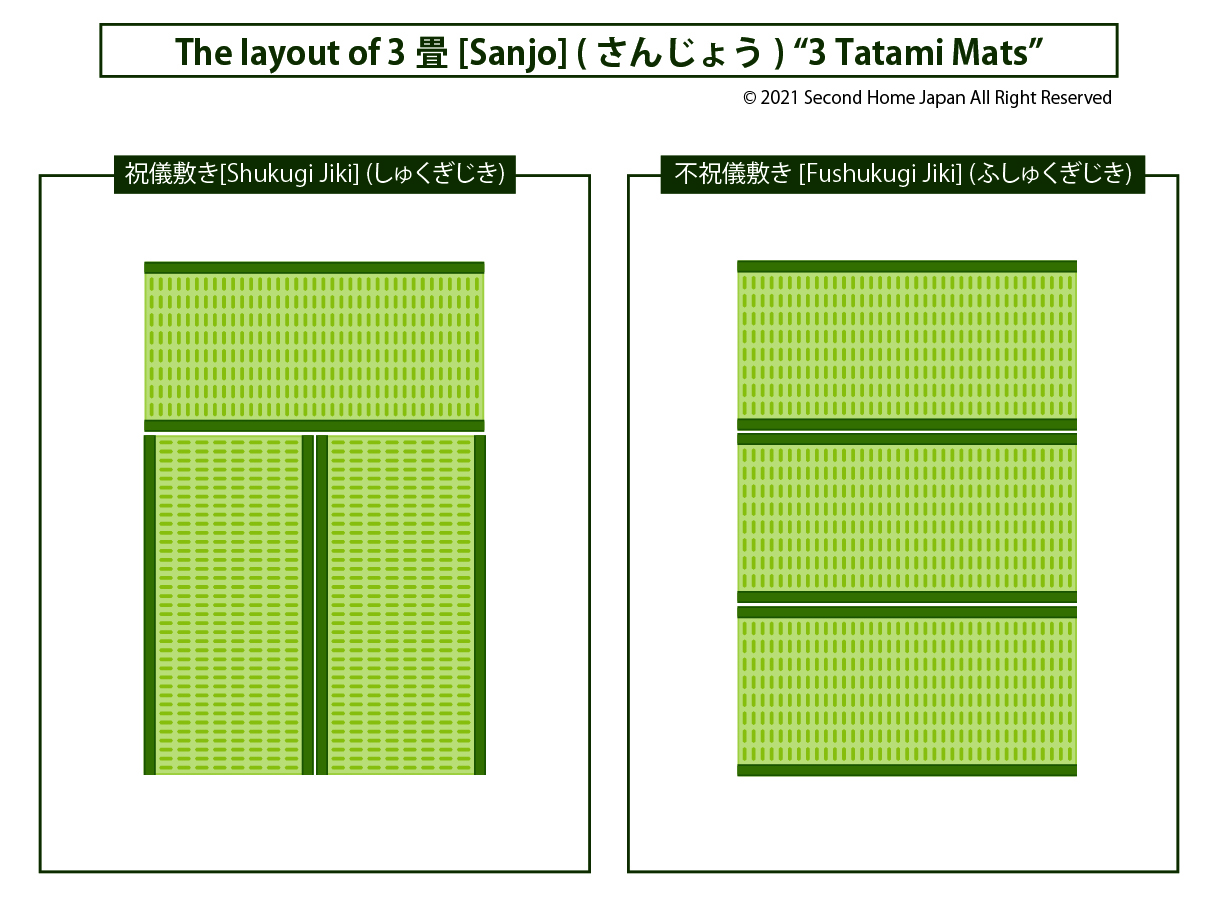
四畳半 [Yojo han] (よじょうはん) ”4.5 Tatami Mats”
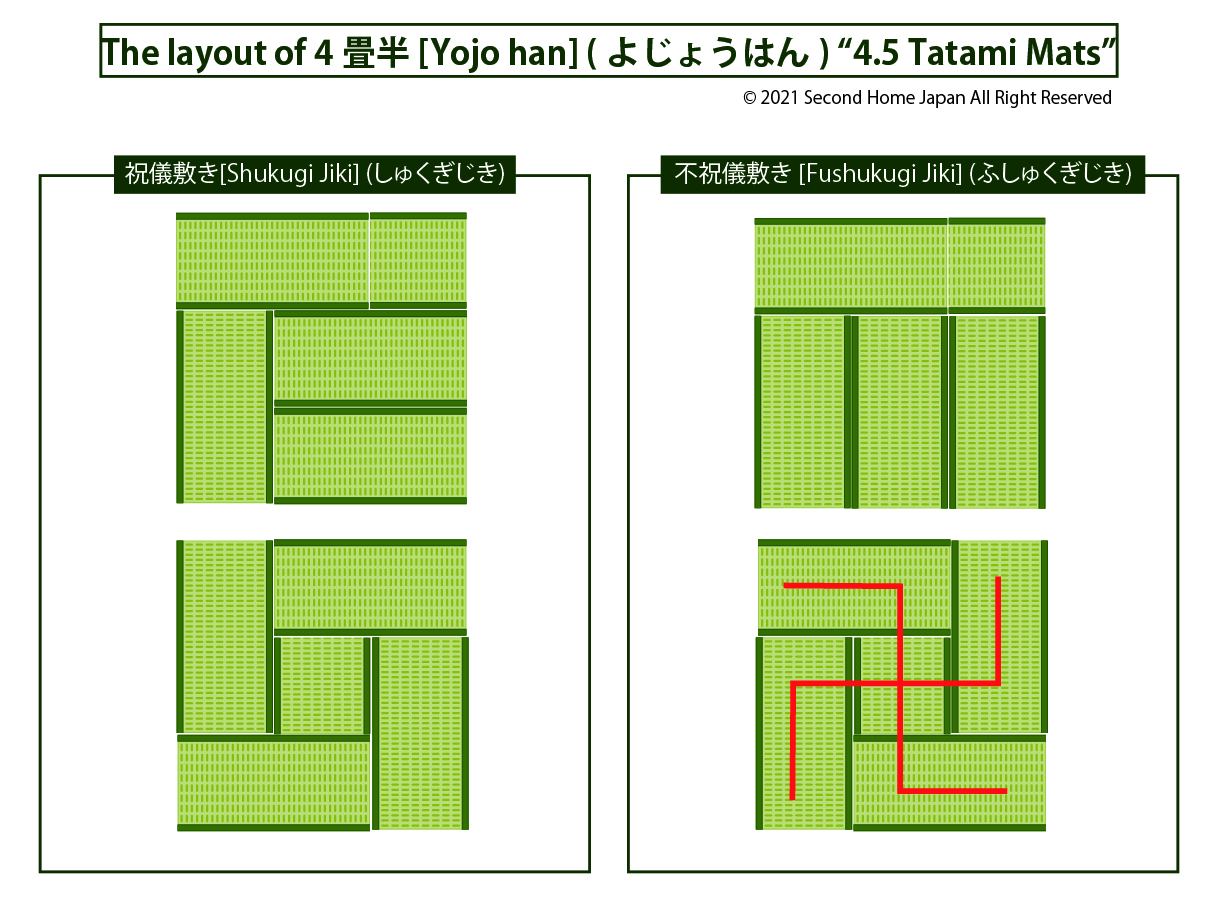
六畳半 [Rokujo] (ろくじょう) ”6 Tatami Mats”
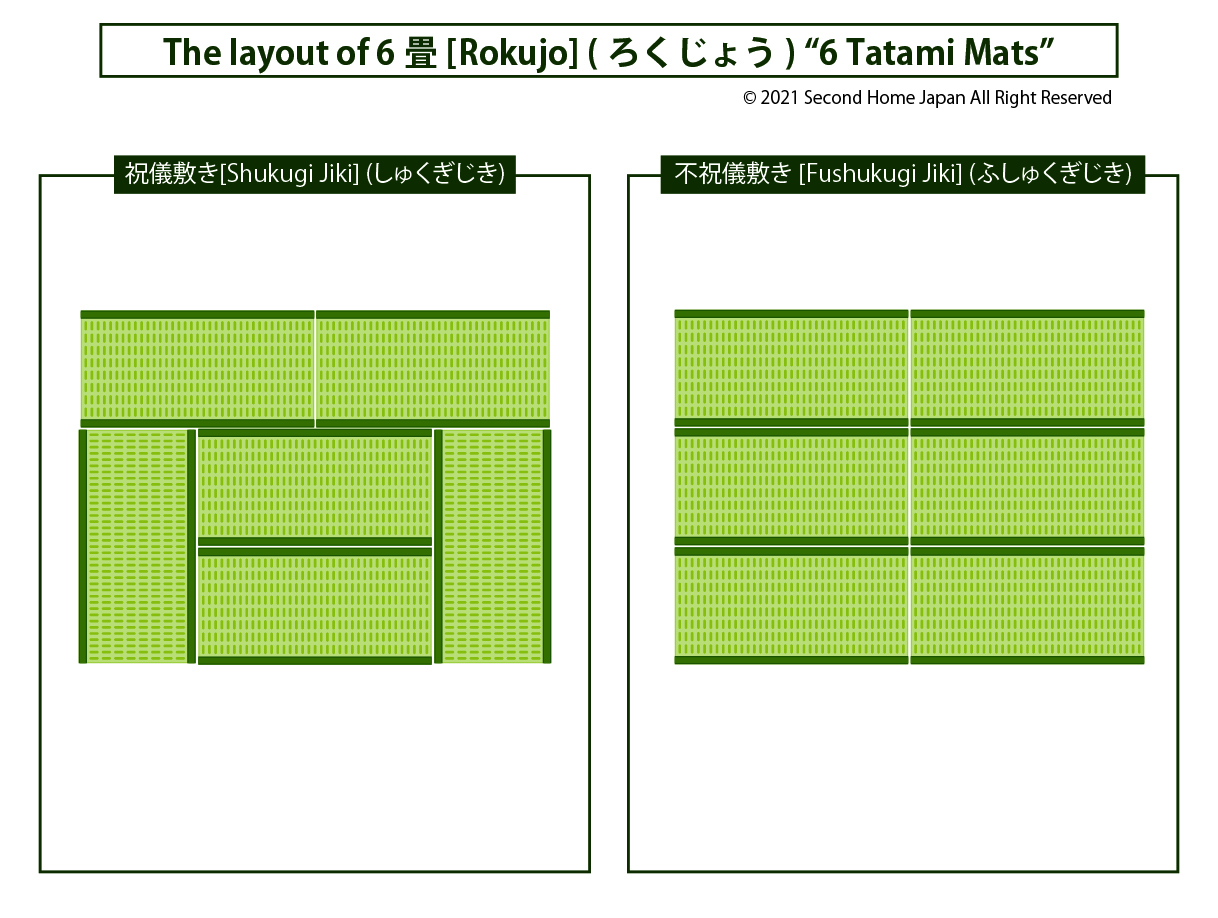
八畳半 [Hachijo] (はちじょう) ”8 Tatami Mats”
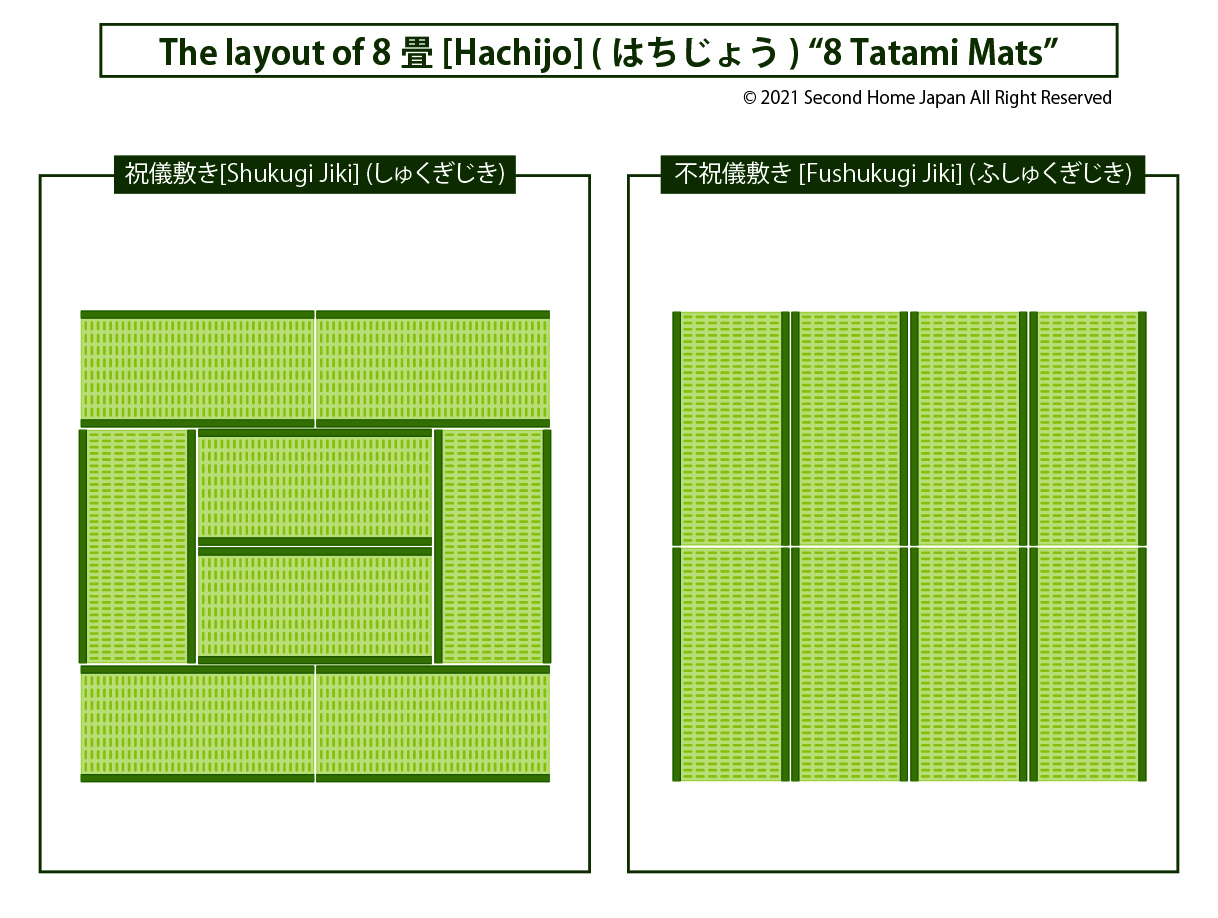
十畳半 [Juujo] (じゅうじょう) ”10 Tatami Mats”
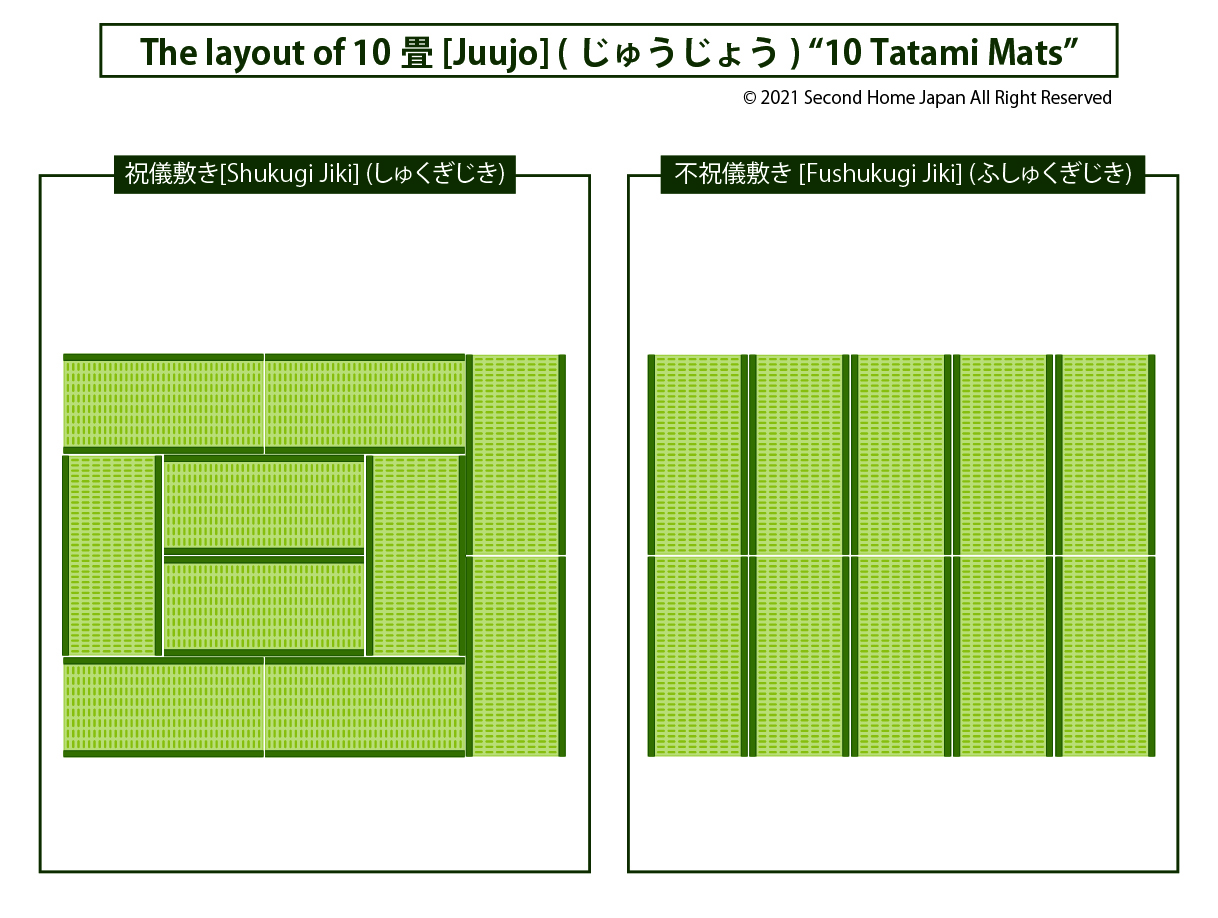
十二畳半 [Juunijo] (じゅうにじょう) ”12 Tatami Mats”
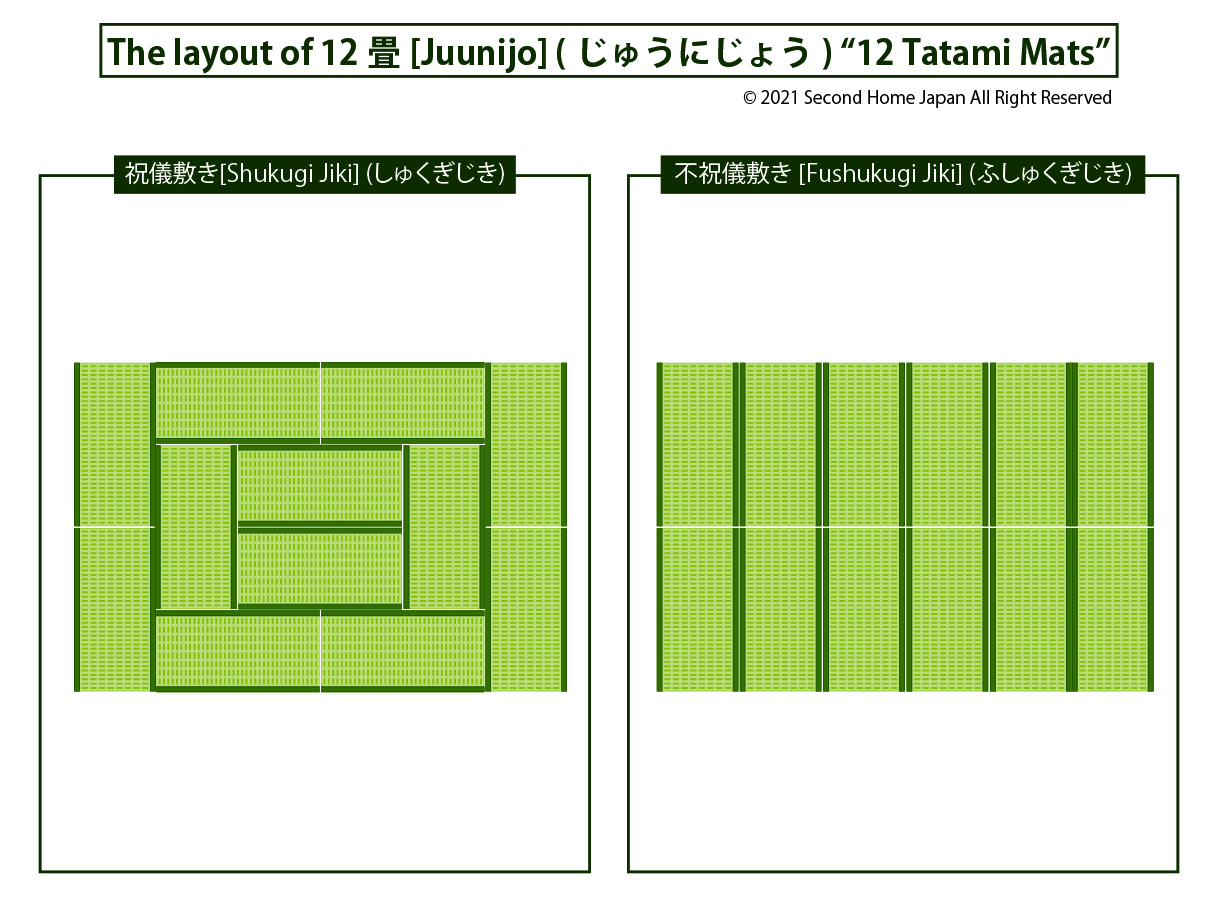
The layouts that brings bad luck
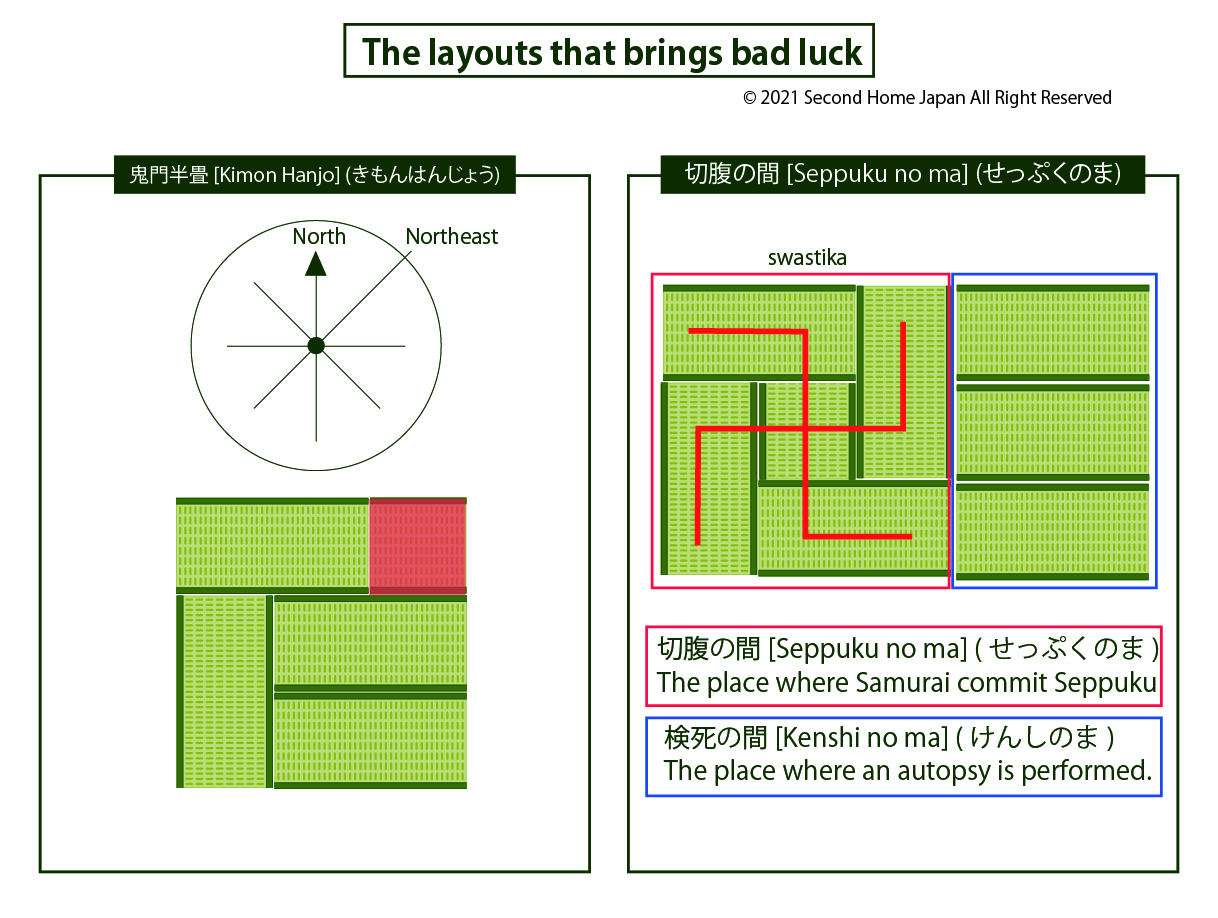
鬼門半畳 [Kimon Hanjo] (きもんはんじょう)
When using a half tatami mat like a 4.5 tatami mat, its location is important. The location of the half-tatami should avoid the “demon’s gate (northeast),” which is said to be the direction from which demons enter and leave the house. Japanese people also take the devil’s gate into consideration when deciding the layout of their houses.
切腹の間 [Seppuku no ma] (せっぷくのま)
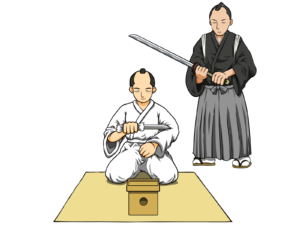 This is the layout used by samurai in the Edo period to commit 切腹 [Seppuku] (せっぷく). 3-tatami mats room was placed next to the room for the autopsy of a samurai who had committed seppuku. For this reason, the layout of 7.5 tatami mats was also considered bad luck among samurai. It is also called 卍敷き [Manji Jiki] (まんじじき).
This is the layout used by samurai in the Edo period to commit 切腹 [Seppuku] (せっぷく). 3-tatami mats room was placed next to the room for the autopsy of a samurai who had committed seppuku. For this reason, the layout of 7.5 tatami mats was also considered bad luck among samurai. It is also called 卍敷き [Manji Jiki] (まんじじき).
Usage for Tatami
Even now that the Western way of living has become popular, the average Japanese house or apartment has at least one room with tatami.
Tatami rooms with a sense of openness provide relaxation and peace of mind. In traditional Japanese culture, tatami rooms have served to entertain guests, hold tea ceremonies, and house Buddhist altars. The room’s airy design, straw mats and simple decorations also helped to alleviate the heat of the humid Japanese summer. Today, tatami rooms are often used as living rooms or bedrooms. They are also used as yoga studios and meditation spaces thanks to their airy atmosphere and minimalist furnishings.
Sleeping on tatami
 Japanese people have long slept on tatami mats with 布団 [futon] (ふとん) laid out on top. A Japanese-style room with tatami mats has a closet in which the futon can be stored. When you sleep at night, you lay out your futon, but during the day, you store your futon in the closet, which means you can use the Japanese-style room for various purposes.
Japanese people have long slept on tatami mats with 布団 [futon] (ふとん) laid out on top. A Japanese-style room with tatami mats has a closet in which the futon can be stored. When you sleep at night, you lay out your futon, but during the day, you store your futon in the closet, which means you can use the Japanese-style room for various purposes.
When guests come to stay, just add 布団 [futon] (ふとん) and it can become a bedroom for your guests.
In Japanese households, it is common for children to sleep in the same room as their parents. If you sleep with a baby in a futon together, you don’t have to worry about his/her tumbling down.
Eating on Tatami
 In a small house, a tatami room may be used as a dining room. If you put a ちゃぶ台 [chabudai] (ちゃぶだい) round table in the tatami room and eat in a circle, you can enjoy conversation.
In a small house, a tatami room may be used as a dining room. If you put a ちゃぶ台 [chabudai] (ちゃぶだい) round table in the tatami room and eat in a circle, you can enjoy conversation.
Play on the tatami
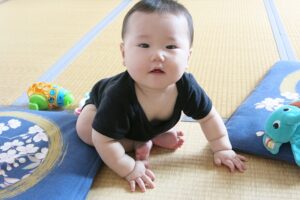 In households with small children, it is not uncommon for a Japanese-style room with tatami mats to be used as a playroom for children. Tatami is resilient, so it is safe for small children to jump and play on it.
In households with small children, it is not uncommon for a Japanese-style room with tatami mats to be used as a playroom for children. Tatami is resilient, so it is safe for small children to jump and play on it.
Play 将棋 [Shogi] (しょうぎ) , 囲碁 [igo] (いご) or かるた [karuta] on the tatami
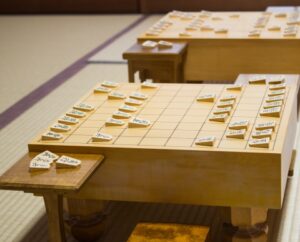 Igo and Shogi are a traditional Japanese board game. When you play Igo or Shogi competitively, it is also played in a Japanese-style room with tatami mats.
Igo and Shogi are a traditional Japanese board game. When you play Igo or Shogi competitively, it is also played in a Japanese-style room with tatami mats.
かるた [karuta] are Japanese playing cards. When you play Karuta competitively, the playing field would be Japanese room with tatami.
Relaxing on Tatami
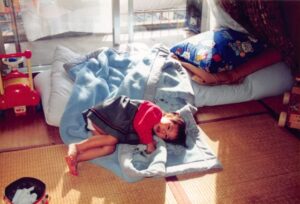 Tatami is moderately cool in summer and does not get cold in winter like wood flooring. It can be a great place to lie down while watching TV or to take a nap.
Tatami is moderately cool in summer and does not get cold in winter like wood flooring. It can be a great place to lie down while watching TV or to take a nap.
Exercising on Tatami
Tatami is not too hard, not too soft, and has just the right amount of elasticity, making it ideal for yoga and flexibility exercises.
Sports on Tatami
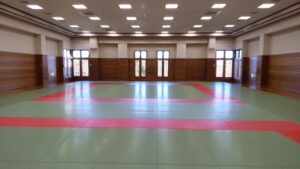 Tatami mats are laid out in 武道館 [budo kan] (ぶどうかん) budo halls where 武道 [budo] (ぶどう) such as 剣道 [kendo] (けんどう) or 柔道 [judo] (じゅうどう) are performed.
Tatami mats are laid out in 武道館 [budo kan] (ぶどうかん) budo halls where 武道 [budo] (ぶどう) such as 剣道 [kendo] (けんどう) or 柔道 [judo] (じゅうどう) are performed.
Cultures on Tatami
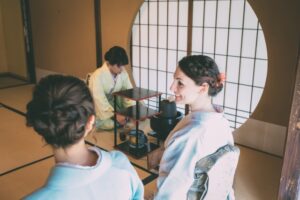 茶道 [sado] (さどう)”Tea ceremony”, 華道 [kado] (かどう) “flower arrangement”, 書道 [shodo] (しょどう) “calligraphy”, etc. are typical Japanese cultural activities, which are also performed in tatami rooms.
茶道 [sado] (さどう)”Tea ceremony”, 華道 [kado] (かどう) “flower arrangement”, 書道 [shodo] (しょどう) “calligraphy”, etc. are typical Japanese cultural activities, which are also performed in tatami rooms.
Other ways to use tatami
Recently, Japanese houses are becoming more Westernized, but they often have spaces with tatami in parts of them.
For example, they are called ユニット畳 [unit datami] (ゆにっとだたみ) or 置き畳 [oki datami] (おきだたみ), and can be easily laid over the floor of a Western room to create a tatami space.
There are also beds where the floor of the bed is made of tatami material.
Features of Tatami
Tatami has various functions such as heat insulation, heat retention, and elasticity due to its structure.
Humidity control & Clean air
Tatami omote and Tatami toko also have the effect of purifying the air in the room.
Each tatami mat can absorb up to 500cc of moisture and humidity, and when the weather is dry, the tatami will release the moisture from itself. Tatami works in harmony with the Japanese climate to regulate humidity.
Also, the natural igusa of tatami mat surface has the power to absorb carbon dioxide, dust, and dirt, many of which are converted into harmless carbon monoxide and returned to the air.
Tatami, which is well suited to the Japanese climate, circulates and adjusts the air in the room to keep it clean. In this way, tatami is best suited to the climate and climate of Japan, and the natural scent of rushes, the simple feel, and the large capacity of tatami create a place of relaxation.
Health
The firmness of tatami eases the tension in your joints, allowing you to naturally sleep in the correct posture. When you walk barefoot on tatami, the shock-absorbing effect of the rice straw eases the impact on your calves and knees.
Environment
The rushes and rice straw used for tatami can be grown in a single harvest. It is said that tatami can last up to 15 years without any scientific treatment. They can be completely composted and recycled.
How to clean and maintain Tatami
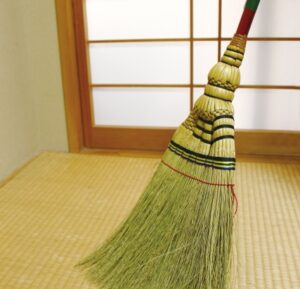 A broom is more suitable for cleaning tatami mats than a vacuum cleaner. This is because a broom, which has the power to scoop out dust, is easier to remove dirt from the crevices of fine-grained tatami than a vacuum cleaner. However, there are many people these days who do not have brooms for indoor use. Of course, you can clean tatami with a vacuum cleaner without any problem, so there is no need to force yourself to prepare a broom.
A broom is more suitable for cleaning tatami mats than a vacuum cleaner. This is because a broom, which has the power to scoop out dust, is easier to remove dirt from the crevices of fine-grained tatami than a vacuum cleaner. However, there are many people these days who do not have brooms for indoor use. Of course, you can clean tatami with a vacuum cleaner without any problem, so there is no need to force yourself to prepare a broom.
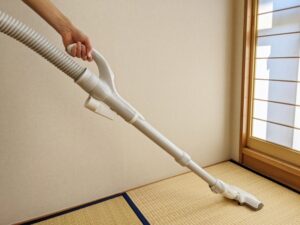 But, robot-type vacuum cleaners, which are becoming more and more popular these days, are not recommended for cleaning tatami. This is because robot vacuum cleaners, which work automatically, do not follow the grain of tatami and may damage tatami. For cleaning tatami mats, please use a general vacuum cleaner that works manually.
But, robot-type vacuum cleaners, which are becoming more and more popular these days, are not recommended for cleaning tatami. This is because robot vacuum cleaners, which work automatically, do not follow the grain of tatami and may damage tatami. For cleaning tatami mats, please use a general vacuum cleaner that works manually.
Simply vacuum along the grain of the tatami or sweep with a broom, and then wipe dry with a dust cloth to scrape off any dust that cannot be removed by a vacuum cleaner. If your vacuum cleaner has a tatami mode, use it to prevent damage to the tatami. The trick is to vacuum slowly. Take your time to clean.
What you should pay attention to is the 縁 [heri / fuchi] area of tatami, which is easily damaged. To prevent damage, do not vacuum the 縁 [heri / fuchi] area.
In addition, since tatami tends to grow mold when it absorbs moisture, basically wipe it with a dry cloth. If you are concerned about dirt, wet a cloth and squeeze it tightly. After that, wipe with a dry cloth and let the tatami dry thoroughly by allowing the Japanese room to air dry.
Remove rugs, etc. laid on top of tatami at least once a week, and open a window to expose it to fresh air. Exposure to direct sunlight can sterilize surfaces. If your tatami is new, it absorbs moisture more easily. On humid days (especially in the rainy season and summer), expose the surface of your tatami more often. Sanitize the surface of tatami with rubbing alcohol or a steam iron. Spraying with steam will also kill mites. Do not iron the surface If possible, hang the rug outdoors and expose both sides to sunlight.
Etiquette in using a tatami room
Of course, you should not enter a tatami room with your shoes on, but you must also take off your slippers at the entrance of a Japanese-style room. Slippers must also be taken off at the entrance of a Japanese room, and the 縁 [heri / fuchi] area of tatami must not be stepped on.
Sitting styles on Tatami
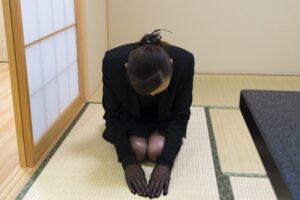 Japanese people have long had a lifestyle of sitting directly on the floor without using chairs. There are many different styles of sitting on tatami mats in a Japanese-style room.
Japanese people have long had a lifestyle of sitting directly on the floor without using chairs. There are many different styles of sitting on tatami mats in a Japanese-style room.
Some of the more well-known styles are
– 正座 [seiza] (せいざ) : the most formal way
– 横座り [yokosuwari] (よこすわり) : the way to sit for more common among women
– 長座 [chouza] (ちょうざ) : the way to sit with your knees extended and feet forward.
– あぐら[agura] : the way to sit with your legs crossed flat in front of you, it’s like a yoga pose
– 体育座り [taiku suwari] (たいくずわり) : the way to sit, hugging your knees to your chest, In Japan, this sitting style is common in physical education classes.
Although tatami has elasticity due to its structure and the characteristics of igusa, it is not desirable to sit in the same posture for a long time in order to enjoy a relaxing moment in a tatami space. Use a chair, cushions, or a 座布団 [zabuton] to sit in a relaxed position.
However, for funerals and other occasions, sit in 正座 [seiza] (せいざ), which is the most formal way to sit.
Origin of the Japanese word “tatami”
The origin of the Japanese word tatami can be traced back to the verb “tatamu,” meaning to fold. Traditionally woven from rice straw, tatami was a 3-foot by 6-foot pad that Japanese men and women used to sit or sleep comfortably on the floor. Tatami was folded or stacked when not in use; dating back to the 8th century, tatami was a symbol of social status. As far back as the 8th century, tatami was a symbol of social status; only the wealthy could afford to rest on them, while the common people were forced to sit on the bare floor.
History of Tatami
Tatami is an indigenous Japanese rug, although many of them were introduced to Japan from China. In the oldest Japanese history book called 古事記 [Kojiki] (こじき), there is a description of a layered rug that is the prototype of today’s tatami.
It was during the Heian period (794-1185) that the structure resembling the present tatami mat was developed. Tatami was used as seating or bedding on a wooden floor, and the thickness of the tatami, as well as the pattern and color of the Heri, differed depending on the status of the user.
From the Kamakura period to the Muromachi period, the 書院造 [shoin-zukuri] (しょいんづくり) style was born, and the use of tatami developed to cover the entire room. Until then, tatami had been used for entertaining 貴族 [kizoku] (きぞく) “noblemen” and guests, but it came to be used as flooring material for buildings. However, such usage also symbolized the wealth of the 貴族 [kizoku] (きぞく) “noblemen and 武士 [bushi] (ぶし) “warriors”. During the Momoyama period and into the Edo period, tatami gradually came to be used in the homes of townspeople as the 数寄屋造り [sukiya zukuri] (すきやづくり) sukiya style and the tea ceremony developed and spread. Even so, the custom of restricting the use of tatami according to status remained, and it was not until the middle of the Edo period that ordinary people were able to use tatami.
Until then, wild igusa was used, but full-scale cultivation began, and in the late Edo period, the professions of 畳職人 [tatami shokunin] (たたみしょくにん)”tatami craftsman” and 畳屋 [tatami ya] (たたみや) “tatami maker” were born.
In the Meiji era (from around 1868)
Until then, there were restrictions on tatami patterns, but these restrictions were lifted and tatami was widely introduced to the general public after the 明示維新 [meiji ishin] (めいじいしん) “Meiji Restoration”. Tatami was used carefully with wisdom such as drying tatami to prevent it from getting sore or turning it inside out when the front of the tatami becomes burned.
In the Showa era (around 1945-)
With the period of rapid economic growth, people’s lifestyles became more westernized, and they shifted from sitting in Japanese-style rooms to sitting on chairs or sofas. Carpets and other furnishings became widespread, but tatami rooms were still the mainstay of the home.
In the modern age (1990-)
With the widespread use of wooden flooring and the high cost of building a Japanese style room, more and more Japanese rooms are not being built. On the other hand, wooden flooring has disadvantages such as coldness in the room, echoing sound, and uncomfortableness, so tatami is being reevaluated again. Tatami mats that can be placed on wooden floors and 琉球畳 [ryukyu datami] (りゅうきゅうだたみ) “Ryukyu style tatami mats” are gradually gaining popularity. The popularity of tatami is gradually reviving with the use of scientific materials and higher functionality to meet our needs.

